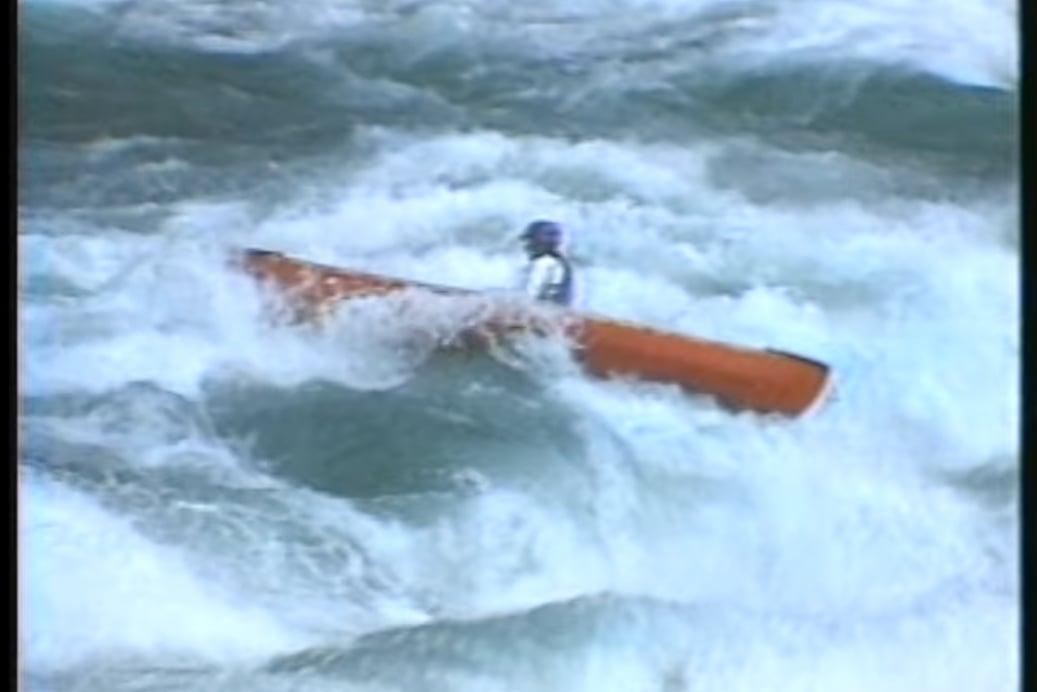In the wake of the largest waterfall in North America is a set of rapids so dangerous to run that it’s illegal. Niagara Falls sees four of the Great Lakes tumble 70-180 ft (21-57 m) with a flow rate around 100,000 cubic feet per second (cfs) during the high season, making it the largest waterfall in North America by volume.
At the bottom of the falls lies Niagara Gorge with massive whirlpools, standing waves so large they earned the name “the Himalayas”— some of the biggest whitewater in the world. The Gorge includes the only eddy to appear on a world atlas, a quarter mile long.
It took a two year legal battle with the New York Supreme Court for Risa Shimonda Callaway, Woody Callaway and Nolan Whitesell to get permission to run the gorge in 1987; Whitesell ran the Gorge in an open canoe, and remains the first and only recorded person to run Niagara Gorge in an open canoe.

Running Niagara Gorge in an open canoe
“It’s one really enticing, mighty tantalizing and tempting piece of whitewater,” Nolan Whitesell said in a video documenting the run of Niagara Gorge.
Whitesell in 1984 became the first known person to run every rapid in the Grand Canyon in an open canoe, as well as Idahos’ North Fork Payette. According to an article in Men’s Journal, in order to get the permit to run Niagara, Whitesell put up his home as collateral against the cost of potential rescue.
Scouting the rapid was easy for the team, with two different countries to view from as well as elevators and observation decks but below the river is continually changing, with massive standing waves shifting and whirlpools materializing and fading.
“The only thing that’s consistent is the overwhelming hope that there must be a better route on the other side of the river,” Whitesell explained.
History of running Niagara Gorge
On June 6, 1891 Captain Joel Robinson became the first known person to navigate Niagara Gorge when he navigated the Maid of the Mist steamer through the rapids in order to make a date to sell the boat on Lake Ontario.
Along with the boat’s mechanic James McIntyre and engineer James Jones, Robinson took the steamer through Great Gorge Rapids, the Whirlpool, and the Lower Rapids at an estimated 250,000 cfs. Reportedly, the boat ripped through Great Gorge Rapids at nearly 40 miles per hour (63 kilometers per hour) and it wasn’t until the Whirlpool that Captain Robinson regained control of the boat and ran the rest of the rapids by sticking to the middle of the river. The boat and everyone aboard made it through intact, minus the smoke stack which they lost along the way.
In 1975, a rafting company briefly operated in the Gorge, but closed after one of the 37-ft rafts flipped on their eleventh run, resulting in three passenger drownings.
In October 1982 Chris Spelius, Don Deedon, Carrie Ashton, and Kenneth Lagergren ran the rapids in the first recorded legal run. Before the first known legal run, the first known descent is credited to Chris Spelius and Ken Lagergren; after the first descent Lagergren was arrested, and Spelius escaped.
Since then, there have been a number of semi-legal runs of the gorge in whitewater kayaks; Whitesell remains the only run of Niagara Gorge in an open canoe.




